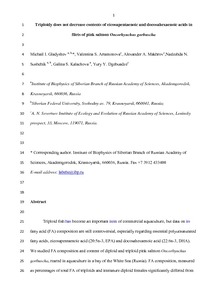Показать сокращенную информацию
Triploidy does not decrease contents of eicosapentaenoic and docosahexaenoic acids in filets of pink salmon Oncorhynchus gorbuscha
| Автор | Гладышев, М. И. | |
| Автор | Артамонова, В. С. | |
| Автор | Махров, А. А. | |
| Автор | Сущик, Н. Н. | |
| Автор | Калачева, Г. С. | |
| Автор | Дгебуадзе, Ю. Ю. | |
| Дата внесения | 2016-11-11T08:52:11Z | |
| Дата, когда ресурс стал доступен | 2016-11-11T08:52:11Z | |
| Дата публикации | 2016-08 | |
| Библиографическое описание | Гладышев, М. И. Triploidy does not decrease contents of eicosapentaenoic and docosahexaenoic acids in filets of pink salmon Oncorhynchus gorbuscha [Текст] / М. И. Гладышев, В. С. Артамонова, А. А. Махров, Н. Н. Сущик, Г. С. Калачева, Ю. Ю. Дгебуадзе // Food Chemistry. — 2016. — Т. 216. — С. 66-69 | |
| ISSN | 03088146 | |
| URI (для ссылок/цитирований) | https://elib.sfu-kras.ru/handle/2311/27981 | |
| Аннотация | Triploid fish has become an important item of commercial aquaculture, but data on its fatty acid (FA) composition are still controversial, especially regarding essential polyunsaturated fatty acids, eicosapentaenoic acid (20:5n-3, EPA) and docosahexaenoic acid (22:6n-3, DHA). We studied FA composition and content of diploid and triploid pink salmon Oncorhynchus gorbuscha, reared in aquaculture in a bay of the White Sea (Russia). FA composition, measured as percentages of total FA of triploids and immature diploid females significantly differed from that of mature diploid fish. Specifically, mature diploids had higher percentage of EPA and DHA in their muscle tissue (filets) compared to that of triploids and immature diploid females. Nevertheless, the contents of EPA and DHA per mass of the filets in diploid and triploid specimens were similar. Thus, no special efforts are needed to improve EPA and DHA contents in filets of triploids. | |
| Ссылка на другой сайт | http://www.sciencedirect.com/science/article/pii/S0308814616312511 | |
| Тема | Essential fatty acids | |
| Тема | Triploid fish | |
| Тема | Filets | |
| Название | Triploidy does not decrease contents of eicosapentaenoic and docosahexaenoic acids in filets of pink salmon Oncorhynchus gorbuscha | |
| Тип | Journal Article | |
| Тип | Journal Article Preprint | |
| Страницы | 66-69 | |
| ГРНТИ | 34.35.33 | |
| Дата обновления | 2016-11-11T08:52:11Z | |
| DOI | 10.1016/j.foodchem.2016.08.021 | |
| Институт | Институт фундаментальной биологии и биотехнологии | |
| Подразделение | Кафедра водных и наземных экосистем | |
| Журнал | Food Chemistry | |
| Квартиль журнала в Scopus | Q1 | |
| Квартиль журнала в Web of Science | Q1 |

